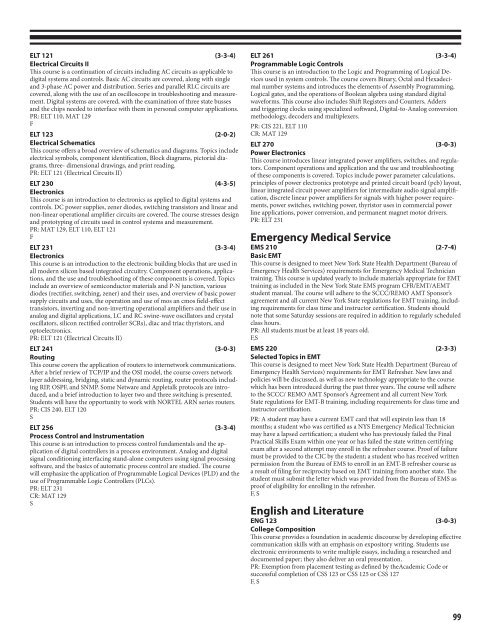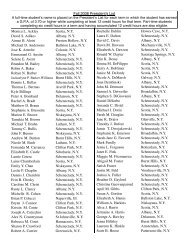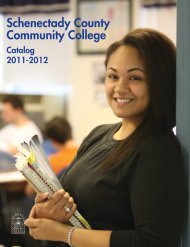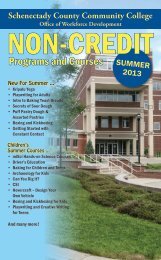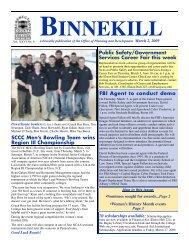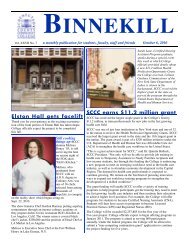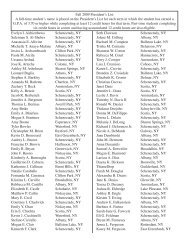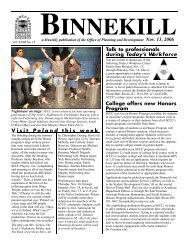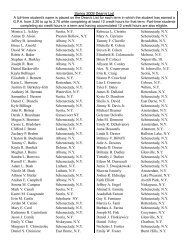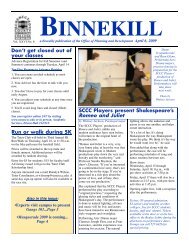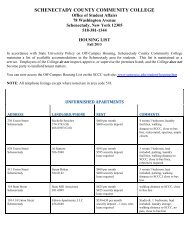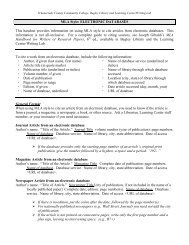ECH 220 (3-0-3)Engendering Creativity: Arts in the ClassroomThis course is an exploration of creative expression with an emphasis placed onthe importance of the arts in every child’s education. As students unlock theirown creative potential, they also become skilled at using methods and techniquesthat encourage creative development in young children. Students reflecton aesthetics while analyzing the movements and techniques of the visual artsand the genres and elements of music. Students then apply their understandingby presenting art, music, and drama activities to young children. Throughoutthe semester, students develop an art and music portfolio.ECH 223 (3-0-3)Curricular Methods II and the Development of Inquiry SkiThis course focuses on the early developmental abilities of children ages birthto eight years in social studies, math and science. Sensory, preoperational andconcrete operational thought processes of conservation, seriation, observation,comparison, classification, and number concepts will be examined through theuse of concrete social studies, math, and science materials and experiences thatfoster student quantitative and analytical thinking. The course requires studentsto implement developmentally appropriate social students, math, and scienceactivities which address diversity in children’s learning styles. A service learningexperience is required.PR: ECH 123ECH 225 (3-2-4)Fostering Emergent LiteracyThe course examines the development of literacy skills in children ages birth to8 years. Multiple opportunities to recognize the developmental stages in literacyacquisition, to indentify factors that influence literacy development, and todiscuss how to design and implement a literacy program are provided. Genreof literature, curricular themes, and resources for children of culturally andlinguistically diverse backgrounds are empasized. Guidelines for the design andimplementation of literature- based activities are applied throughout the course.Students will observe for a minimum of 15 hours in an early childhood literacyenvironment.ECH 227 (3-0-3)Guidance of Young ChildrenThis course focuses on the early developmental abilities of children ages birthto eight years and approriate utilization of guidance strategies to enhance children’sself esteem and consequently increase children’s self- discipline skills. Thecorrelation between children’s environments and behaviors will be researched.The importance of play, social interactions, and family expectations on children’sdevelopment will be analyzed.ECH 231 (1-8-4)Early Childhood Field Instruction and Seminar IIThis course allows students the opportunity for direct practical teaching andlearning in early childhood education within community agencies or the SCCCEarly Childhood Program Laboratory Preschool. The course requires studentsto reflect on and share their experiences in a seminar setting. The course alsorequires students to spend eight to ten hours per week in their field placementto accumulate a minimum of 130 hours. A service learning implementation isrequired.PR: ECH 131FECH 252 (3-0-3)Care of Infants and ToddlersThis course examines infant and toddler development with an emphasis on theimportance of the first thirty-six months in relation to human development.Attachment, early brain research and developmentally appropriate practiceswill be emphasized as critical factors which impact a caregiver’s role in meetingindividual children’s needs. Students complete ten hours of observational fieldwork in this course.ECH 255 (3-0-3)Administration of Early Childhood ProgramsThis course provides administrative management training in the field of EarlyChildhood Education. This course addresses issues and techniques involvedin the set-up, organization and administration of early childhood environments.Focus is placed on the initiation and maintenance of an early childhoodprogram which includes the investigation and application of pertinent skillsnecessary to perform as an effective and competent program director. Ten hoursof field work will be completed in this course.ECH 260 (1-0-1)ECH Portfolio SeminarThis capstone seminar is intended for ECH majors who are about to graduatefrom their Early Childhood Program. Knowledge and skills acquired in theprogram are reviewed and analyzed to demonstrate their proficiency in a preprofessionalportfolio. Opportunity is provided for technical assistance on anindividual basis. Each student assembles a portfolio as a summative experienceto be presented to a professional review team.PR: Permission of the DepartmentEconomicsECO 211 (3-0-3)Introduction to EconomicsThis course provides an overview of microeconomic and macroeconomic issuesand an understanding of the economic choices that individuals, firms, andgovernments face. It also introduces the concept of scarcity and the workingprocess of a market economic system. Further, this course examines the differentmarket structures, the role of the firm and the impact of government interventionon markets. Finally, this course discusses the meaning and computationof national income, inflation, unemployment, economic growth, internationaltrade, and the impact of fiscal and monetary policies on the economy.F, SECO 221 (3-0-3)Principles of MacroeconomicsThis course provides an analytical framework for the understanding of theeconomy at the national level. This course will also analyze the purpose andfunctions of national income accounting, the components of Gross DomesticProduct, the determinants of long run economic growth, the causes and costs ofinflation and unemployment. In addition, this course will cover the economicimpacts of fiscal and monetary policies and the differences between short runand long run macroeconomic aspects of the economy. Finally, this course willexamine the importance of the U.S. financial system, the macroeconomic effectsof international trade and the determination of interest and exchange rates.F,SECO 223 (3-0-3)Principles of MicroeconomicsThis course develops an analytical framework for the understanding of the theoryof markets, including the decision-making process in businesses, the impactof technological advances on markets and the functioning of the four differentmarket structures. This course will also provide a closer look at the interactionsof individual households, business firms and governments in the marketplace.Finally, this course will discuss economic issues related to the well-being ofmarket participants, the tradeoffs between equity and efficiency, the economicsof taxation and subsidies, the economics of healthcare, the economics of povertyand income inequality, labor market issues and the basis of free trade.F, SElectrical TechnologyELT 110 (3-3-4)Electrical Circuits IThis course is an introduction to direct current (DC) circuits. Digital systemsand circuits using logical gates will also be studied. Basic DC circuits entailsa study of Ohm’s Law and use of the law to theoretically predict measuredvoltages, currents, resistances and power through resistors connected in series,parallel and series-parallel circuits. This course uses voltmeters, ammeters,ohmmeters, multimeters, and oscilloscopes for measurement andtroubleshooting.PR: MAT 128 or higherSELT 118 (3-0-3)Digital LogicThis course is an introduction to the basic concepts of number systems,Boolean algebra, logic gates, codes, binary arithmetic and digital circuits usingIntegrated Circuit Technology.98
ELT 121 (3-3-4)Electrical Circuits IIThis course is a continuation of circuits including AC circuits as applicable todigital systems and controls. Basic AC circuits are covered, along with singleand 3-phase AC power and distribution. Series and parallel RLC circuits arecovered, along with the use of an oscilloscope in troubleshooting and measurement.Digital systems are covered, with the examination of three state bussesand the chips needed to interface with them in personal computer applications.PR: ELT 110, MAT 129FELT 123 (2-0-2)Electrical SchematicsThis course offers a broad overview of schematics and diagrams. Topics includeelectrical symbols, component identification, Block diagrams, pictorial diagrams,three- dimensional drawings, and print reading.PR: ELT 121 (Electrical Circuits II)ELT 230 (4-3-5)ElectronicsThis course is an introduction to electronics as applied to digital systems andcontrols. DC power supplies, zener diodes, switching transistors and linear andnon-linear operational amplifier circuits are covered. The course stresses designand prototyping of circuits used in control systems and measurement.PR: MAT 129, ELT 110, ELT 121FELT 231 (3-3-4)ElectronicsThis course is an introduction to the electronic building blocks that are used inall modern silicon based integrated circuitry. Component operations, applications,and the use and troubleshooting of these components is covered. Topicsinclude an overview of semiconductor materials and P-N junction, variousdiodes (rectifier, switching, zener) and their uses, and overview of basic powersupply circuits and uses, the operation and use of mos an cmos field-effecttransistors, inverting and non-inverting operational amplifiers and their use inanalog and digital applications, LC and RC swine-wave oscillators and crystaloscillators, silicon rectified controller SCRs), diac and triac thyristors, andoptoelectronics.PR: ELT 121 (Electrical Circuits II)ELT 241 (3-0-3)RoutingThis course covers the application of routers to internetwork communications.After a brief review of TCP/IP and the OSI model, the course covers networklayer addressing, bridging, static and dynamic routing, router protocols includingRIP, OSPF, and SNMP. Some Netware and Appletalk protocols are introduced,and a brief introduction to layer two and three switching is presented.Students will have the opportunity to work with NORTEL ARN series routers.PR: CIS 240, ELT 120SELT 256 (3-3-4)Process Control and InstrumentationThis course is an introduction to process control fundamentals and the applicationof digital controllers in a process environment. Analog and digitalsignal conditioning interfacing stand-alone computers using signal processingsoftware, and the basics of automatic process control are studied. The coursewill emphasize the application of Programmable Logical Devices (PLD) and theuse of Programmable Logic Controllers (PLCs).PR: ELT 231CR: MAT 129SELT 261 (3-3-4)Programmable Logic ControlsThis course is an introduction to the Logic and Programming of Logical Devicesused in system controls. The course covers Binary, Octal and Hexadecimalnumber systems and introduces the elements of Assembly Programming,Logical gates, and the operations of Boolean algebra using standard digitalwaveforms. This course also includes Shift Registers and Counters, Addersand triggering clocks using specialized softward, Digital-to-Analog conversionmethodology, decoders and multiplexers.PR: CIS 221, ELT 110CR: MAT 129ELT 270 (3-0-3)Power ElectronicsThis course introduces linear integrated power amplifiers, switches, and regulators.Component operations and application and the use and troubleshootingof these components is covered. Topics include power parameter calculations,principles of power electronics prototype and printed circuit board (pcb) layout,linear integrated circuit power amplifiers for intermediate audio signal amplification,discrete linear power amplifiers for signals with higher power requirements,power switches, switching power, thyristor uses in commercial powerline applications, power conversion, and permanent magnet motor drivers.PR: ELT 231Emergency Medical ServiceEMS 210 (2-7-4)Basic EMTThis course is designed to meet New York State Health Department (Bureau ofEmergency Health Services) requirements for Emergency Medical Techniciantraining. This course is updated yearly to include materials appropriate for EMTtraining as included in the New York State EMS program CFR/EMT/AEMTstudent manual. The course will adhere to the SCCC/REMO AMT Sponsor’sagreement and all current New York State regulations for EMT training, includingrequirements for class time and instructor certification. Students shouldnote that some Saturday sessions are required in addition to regularly scheduledclass hours.PR: All students must be at least 18 years old.F,SEMS 220 (2-3-3)Selected Topics in EMTThis course is designed to meet New York State Health Department (Bureau ofEmergency Health Services) requirements for EMT Refresher. New laws andpolicies will be discussed, as well as new technology appropriate to the coursewhich has been introduced during the past three years. The course will adhereto the SCCC/ REMO AMT Sponsor’s Agreement and all current New YorkState regulations for EMT-B training, including requirements for class time andinstructor certification.PR: A student may have a current EMT card that will expirein less than 18months; a student who was certified as a NYS Emergency Medical Technicianmay have a lapsed certification; a student who has previously failed the FinalPractical Skills Exam within one year or has failed the state written certifyingexam after a second attempt may enroll in the refresher course. Proof of failuremust be provided to the CIC by the student; a student who has received writtenpermission from the Bureau of EMS to enroll in an EMT-B refresher course asa result of filing for reciprocity based on EMT training from another state. Thestudent must submit the letter which was provided from the Bureau of EMS asproof of eligibility for enrolling in the refresher.F, SEnglish and LiteratureENG 123 (3-0-3)<strong>College</strong> CompositionThis course provides a foundation in academic discourse by developing effectivecommunication skills with an emphasis on expository writing. Students useelectronic environments to write multiple essays, including a researched anddocumented paper; they also deliver an oral presentation.PR: Exemption from placement testing as defined by theAcademic Code orsuccessful completion of CSS 123 or CSS 125 or CSS 127F, S99


